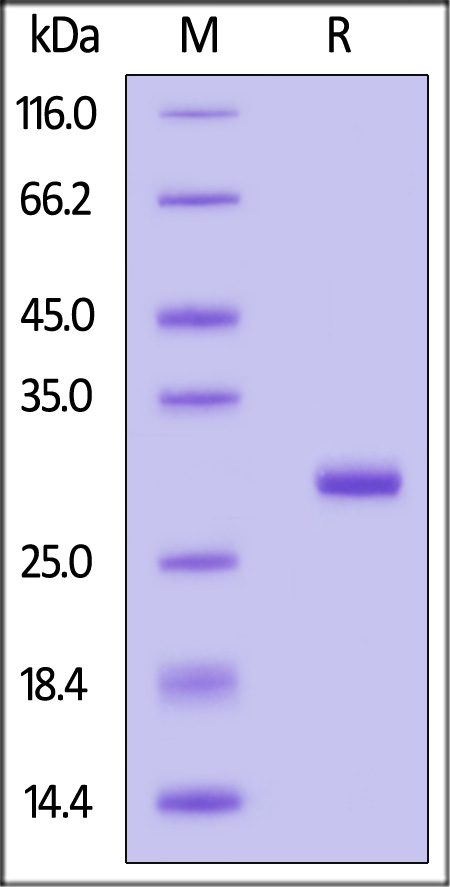分子别名(Synonym)
C1QBP,GC1QBP,HABP1,SF2P32,p33
表达区间及表达系统(Source)
Human HABP1, His Tag (C1P-H5122) is expressed from E. coli cells. It contains AA His 75 - Gln 282 (Accession # Q07021-1).
Predicted N-terminus: Met
Request for sequence
蛋白结构(Molecular Characterization)

This protein carries a polyhistidine tag at the C-terminus.
The protein has a calculated MW of 24.6 kDa. The protein migrates as 28-31 kDa under reducing (R) condition (SDS-PAGE).
内毒素(Endotoxin)
Less than 1.0 EU per μg by the LAL method.
纯度(Purity)
>95% as determined by SDS-PAGE.
制剂(Formulation)
Lyophilized from 0.22 μm filtered solution in PBS, pH7.4. Normally trehalose is added as protectant before lyophilization.
Contact us for customized product form or formulation.
重构方法(Reconstitution)
Please see Certificate of Analysis for specific instructions.
For best performance, we strongly recommend you to follow the reconstitution protocol provided in the CoA.
存储(Storage)
For long term storage, the product should be stored at lyophilized state at -20°C or lower.
Please avoid repeated freeze-thaw cycles.
This product is stable after storage at:
- -20°C to -70°C for 12 months in lyophilized state;
- -70°C for 3 months under sterile conditions after reconstitution.
电泳(SDS-PAGE)

Human HABP1, His Tag on SDS-PAGE under reducing (R) condition. The gel was stained with Coomassie Blue. The purity of the protein is greater than 95%.
背景(Background)
Complement component 1 Q subcomponent-binding protein, mitochondrial (C1QBP), a member of the MAM33 family, is also known as ASF/SF2-associated protein p32, glycoprotein gC1qBP (C1qBP), mitochondrial matrix protein p32 and hyaluronan-binding protein 1, which is a homotrimer that contains three monomers forming a donut-shaped structure with an unusually asymmetric charge distribution on the surface. C1q associates with C1r and C1s in order to yield the first component of the serum complement system. C1QBP has also been identified as the p32 subunit of pre-mRNA splicing factor SF2, as well as a hyaluronic acid-binding protein. Furthermore, C1QBP has been shown to interact with Protein kinase D1, BAT2, PRKCD, PKC alpha and Protein kinase Mζ .























































 膜杰作
膜杰作 Star Staining
Star Staining











